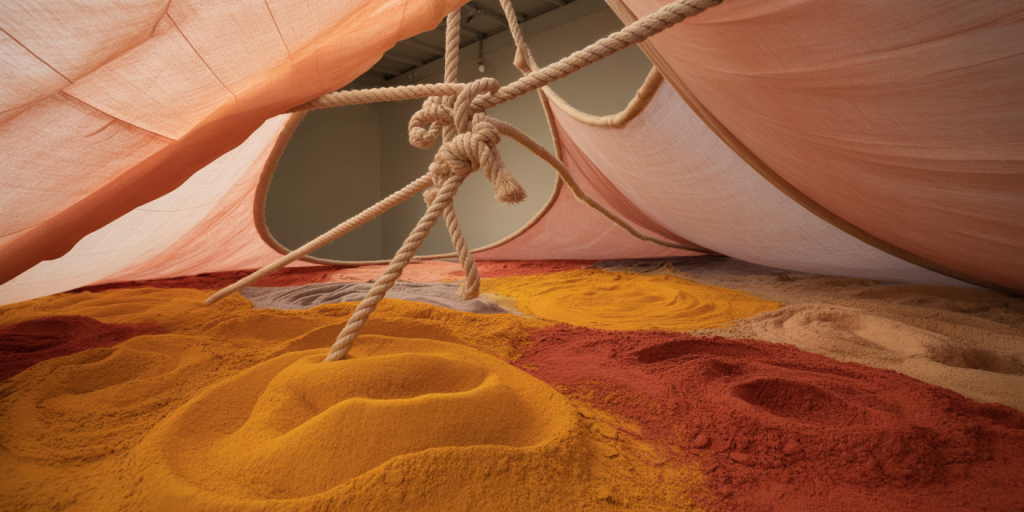When the Body Dissolves: Ernesto Neto and the Organic of the Invisible
There are moments when the body ceases to be a boundary and becomes breath, when skin no longer separates but dissolves, like mist over the sea at dawn. Ernesto Neto does not sculpt figures; he sculpts sensations, spaces, murmurs. In his work, the body is not represented—it is remembered, expanded, diffused. His installations do not ask to be seen; they ask to be entered, inhaled, touched with the gaze of one’s inner self.
Neto’s universe unfolds not in the solidity of mass but in the trembling of membranes, in the soft weight of spices hanging in translucent skins. His materials drip, stretch, pulse—they echo the inside of a womb, the slow rhythm of breathing, the invisible architecture of affection. Entering his spaces is not to visit an artwork, but to inhabit a nervous system that breathes with you, around you, and beyond you.
Summary
- The Softness of Silence
- Where the Skin Meets Air
- Breathing Through Fabric
- The Sensual Architecture of Suspension
- Transparent Bodies of Feeling
- Weights that Ground the Invisible
- The Gravity of Spice
- Smells as Memories of the Flesh
- From Sculptural Mass to Sensory Cloud
- Tentacles of Affection
- Embryonic Light
- The Floating Ritual
- Threads Between Self and Space
- Wombs You Can Walk Into
- When Sculpture Becomes Nest
- Sacred and Sticky
- The Elasticity of the Present Moment
- Fabric as Skin, Skin as Thought
- Thresholds of the Unnamed
- A Poetics of Dissolution
The Softness of Silence
There is a hush in Ernesto Neto’s work—not the silence of absence, but the silence of deep listening. Entering his installations, one feels wrapped in a breath too intimate to be shared aloud. The textures do not shout; they murmur. And in their murmuring, they awaken the body’s memory of touch.
The soft nylon membranes stretch like whispers. They neither resist nor collapse—they receive. In their silence, they offer refuge.
Where the Skin Meets Air
Neto’s materials evoke epidermis: translucent, elastic, porous. His suspended forms often appear as if exhaled by the space itself, hovering between gravity and levity. The skin of his sculptures is not a limit, but a threshold. They breathe with the environment, merging solid and vapor.
Walking among them, the viewer’s own skin becomes sensitized, aware of humidity, temperature, texture. One becomes acutely present at the boundary of being.

Breathing Through Fabric
There is a lung-like quality to Neto’s suspended structures. They inflate and deflate visually, stretching with the air that moves between viewers. They seem to pulse, to dilate, as if the gallery space had developed a respiratory system.
This breathing fabric envelops the viewer—not as a costume, but as an atmosphere. One does not observe; one is absorbed.
The Sensual Architecture of Suspension
Suspension is not merely a technical choice in Neto’s work—it is emotional language. What hangs is vulnerable. What floats is tender. These suspended bodies suggest both delicacy and danger, as though touching them might change their state of being.
The act of hanging becomes an act of waiting. And in that waiting, intimacy grows.
Transparent Bodies of Feeling
The transparency of the material allows inner structures to show—seeds, weights, grains of spice. These are not hidden mechanisms; they are exposed organs. Neto’s sculptures are bodies turned inside out, revealing emotion in every bulbous pouch, every flowing curve.
Their anatomy is affective. They do not bleed, but they offer something deeper: an open vulnerability.
Weights that Ground the Invisible
Every floating element in Neto’s work is countered by weight. Spices fill the membranes, sagging them gently toward the floor. These weights are not anchors—they are tactile reminders of the real.
They give form to what might otherwise be ephemeral. The invisible (scent, sensation, atmosphere) is made visible through mass, and in that mass, memory settles.
The Gravity of Spice
The use of spices—cloves, turmeric, cumin—is not decorative. It is ritualistic, ancestral, deeply bodily. The smells seep into skin, clothes, memory. They carry a lineage of kitchens, temples, ceremonies.
In Neto’s hands, spice becomes pigment, emotion, soul. It drips not just scent, but meaning.

Smells as Memories of the Flesh
Scent is the most primal of the senses. Neto weaves olfactory memory into form. The body cannot help but react: recalling childhood meals, distant markets, the curve of someone’s neck.
His installations smell like places we’ve been but cannot name. They bypass cognition, entering the bloodstream of emotion directly.
From Sculptural Mass to Sensory Cloud
Traditional sculpture celebrates form and solidity. Neto dissolves that. His works are not things—they are clouds, organisms, temporary ecologies. One cannot capture them in a single view.
They expand beyond the visual into spatial experience. One enters the sculpture like mist, like prayer, like song.
Tentacles of Affection
Many of his works sprout long, tubular extensions that hang like arms, intestines, or vines. These tentacles do not reach to grasp—but to touch. To caress the air, the viewer, the floor.
They are limbs of emotion. They are the artist’s desire made physical: the need to extend oneself toward the other.
Embryonic Light
Light in Neto’s installations is filtered, diffused, soft. It leaks through fabric like through eyelids. The space feels amniotic—safe, glowing, warm.
This is not theatrical lighting. It is maternal. It wraps the body instead of dazzling it.
The Floating Ritual
Neto’s environments often feel like sacred spaces—though they lack iconography. There are no saints, no altars. And yet, the body slows. Voice quiets. Steps soften.
The ritual here is one of presence. Of tuning in. Of allowing the senses to speak without words.
Threads Between Self and Space
Every cord, every knot, every stitch becomes a connective tissue. Nothing in Neto’s universe is isolated. Everything is tied—to ceiling, to floor, to viewer, to emotion.
These threads are umbilical. They remind us that no being exists alone. That even in art, we are held.

Wombs You Can Walk Into
Neto builds spaces that feel like wombs—round, warm, protective. They do not confront; they cradle. To enter them is to regress and progress at once. One becomes child and spirit simultaneously.
The works do not push us away. They invite us in—to be part of the sculpture, not merely its witness.
When Sculpture Becomes Nest
There is something maternal in Neto’s vision. His works are nests—not in the ornithological sense, but in the spiritual one. They are soft sanctuaries for the soul.
In their curves, we find rest. In their silence, we find resonance. They offer not answers, but shelter.
Sacred and Sticky
Though sacred, Neto’s art is not sterile. It sweats. It smells. It oozes. The sacred here is not distant—it is intimate, bodily, sticky. It clings to fingers and breath.
This profane holiness makes space for the real: for bodies that leak, for emotions that linger, for souls that do not fit clean lines.
The Elasticity of the Present Moment
Neto’s installations stretch time. There are no clocks, no beginnings, no ends. The present becomes elastic—expanding and contracting with breath.
In this time, one does not rush. One dwells. And in dwelling, the body begins to hear what words could never say.
Fabric as Skin, Skin as Thought
His fabric works are skins—not just metaphorically, but neurologically. They feel like thoughts made physical. They vibrate like nerves. The knots, seams, and tears become synapses of an emotional brain.
One touches them and feels not material, but consciousness.
Thresholds of the Unnamed
Neto’s spaces resist labels. They are not galleries, not temples, not playgrounds—but all of these at once. They are thresholds to what we cannot name but always feel.
They are experiences we do not understand until after we leave—and even then, only through the body.
A Poetics of Dissolution
In the end, Neto does not build form—he dissolves it. He invites us to melt: into space, into scent, into the touch of the world. His sculptures are not about being but becoming.
And in becoming, the body sheds its edges. The invisible becomes tactile. And the soul, at last, finds shape in softness.
FAQ – Frequently Asked Questions
Who is Ernesto Neto?
Ernesto Neto is a Brazilian contemporary artist born in 1964. He is known for creating large-scale immersive installations that blend sculpture, architecture, and sensory experience, often incorporating fabric, spices, and organic forms.
What are the main themes in his work?
Neto’s art explores the body, sensuality, memory, ritual, and spirituality. His installations invite multisensory engagement, dissolving the boundary between viewer and artwork.
Why does he use fabric and spices?
Fabric represents the skin—flexible, porous, tender. Spices evoke smell and memory, adding an olfactory dimension that makes the work more visceral and emotional.
What movements or styles influence Neto?
Though unique, Neto’s work is linked to Brazilian Neo-Concretism, Arte Povera, and participatory art. He builds on traditions that privilege the body and the viewer’s experience.
Where can I see his work?
His works have been exhibited in major institutions worldwide, including the Guggenheim, Tate Modern, and the Venice Biennale. Many pieces are designed specifically for the architecture of each space.
Final Reflections – The Body that Spreads in the World
Ernesto Neto does not sculpt statues. He sculpts environments where the body can forget its edges. His works are not objects to admire but spaces to feel, to breathe, to become.
In his universe, the invisible becomes touchable. The sacred becomes fragrant. And the body—once seen as boundary—becomes bridge. A thread between inner and outer, between self and other, between now and always.
